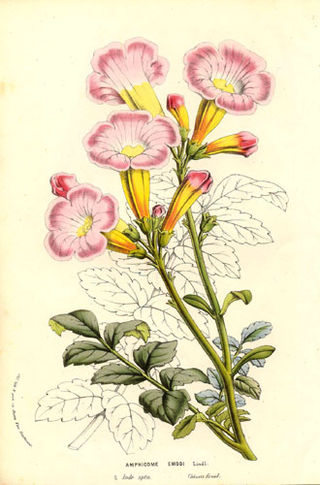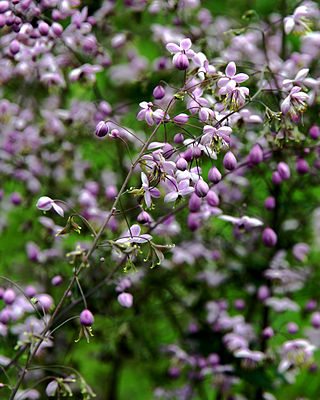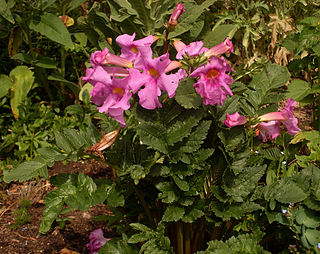Related Research Articles

Firs are evergreen coniferous trees belonging to the genus Abies in the family Pinaceae. There are approximately 48–65 extant species, found on mountains throughout much of North and Central America, Europe, Asia, and North Africa. The genus is most closely related to Cedrus (cedar). The genus name is derived from the Latin "to rise" in reference to the height of its species. The common English name originates with the Old Norse, fyri, or the Old Danish, fyr.

Père Jean-Marie Delavay was a French missionary, explorer and botanist. He was perhaps the first Western explorer of the region which is now encompassed by the Three Parallel Rivers of Yunnan Protected Areas.

Magnolia delavayi is a species of flowering plant in the genus Magnolia. It is known by the common names of Chinese evergreen magnolia or Delavay's magnolia. It was named after Father Delavay, French Catholic missionary in China, who collected it.

Podophyllum is a genus of flowering plant in the family Berberidaceae, native from Afghanistan to China, and from southeast Canada to the central and eastern United States. The genus was first described by Carl Linnaeus in 1753.

Incarvillea is a genus of about 16 species of flowering plants in the family Bignoniaceae, native to central and eastern Asia, with most of the species growing at high altitudes in the Himalaya and Tibet. The most familiar species is Incarvillea delavayi, a garden plant commonly known as hardy gloxinia or Chinese trumpet flower. Unlike most other members of Bignoniaceae, which are mainly tropical woody plants, species of Incarvillea are herbaceous perennial plants from temperate regions.

Cladrastis (yellowwood) is a genus of flowering plants in the family Fabaceae. It includes four species, three native to eastern Asia and one to southeastern North America.

Abies delavayi, the Delavay's silver-fir or Delavay's fir, is a species of fir, native to Yunnan in southwest China and adjoining border areas in southeastern Tibet, far northeastern India, northern Myanmar, and far northwestern Vietnam. It is a high altitude mountain tree, growing at elevations of 3,000–4,000 m, often occupying the tree line.

Metapanax is a genus of flowering plants in the family Araliaceae, comprising 2 species. They are endemic to southern China and Vietnam.
Calanthe delavayi is a species of plant in the family Orchidaceae. It is endemic to China.
Habenaria delavayi is a species of plant in the family Orchidaceae. It is endemic to China.

Apios is a genus of flowering plants in the family Fabaceae. It belongs to the subfamily Faboideae. It contains seven species of perennial climbing herbs or scandent shrubs. Several members of this genus are known to have edible, tuberous roots.

Paeonia delavayi is a low woody shrub belonging to the peonies, that is endemic to China. The vernacular name in China is 滇牡丹. In English it is called Delavay's tree peony, Delavay peony, Dian peony, and dian mu dan. It mostly has red brown to yellow, nodding flowers from mid May to mid June. The light green, delicate looking deciduous leaves consist of many segments, and are alternately arranged on new growth.

Thalictrum delavayi, Chinese meadow-rue, is a species of flowering plant in the family Ranunculaceae native to China. Growing to 1.2 m (4 ft) tall by 60 cm (24 in) wide, it is a herbaceous perennial with leaves divided into many small leaflets, and panicles of lilac flowers with green or white stamens in summer.

Osmanthus delavayi is a species of flowering plant in the olive family Oleaceae. It is an evergreen shrub native to the Guizhou, Sichuan and Yunnan regions of southern China, and widely cultivated as an ornamental in temperate and subtropical zones elsewhere.

Iris delavayi is a species of flowering plant in the subgenus Limniris and in the series Sibiricae of the family Iridaceae. This rhizomatous herbaceous perennial comes from various provinces in China. It has grey-green leaves, long hollow stem, and 2 flowers in various blue shades. From dark violet, dark purple, purple-blue, dark blue to light purple. It is cultivated as an ornamental plant in temperate regions.
Quercus delavayi is an Asian species of trees in the beech family. It has been found only in southern China, in the Provinces of Guizhou, Hubei, Sichuan, Yunnan, and Guangxi. It is placed in subgenus Cerris, section Cyclobalanopsis.

Lonicera similis is a species of flowering plant in the family Caprifoliaceae, native to Western China. This honeysuckle is known in cultivation by the variety delavayi which is reported by some authorities to be synonymous with L. similis itself. It is a large, twining, semi-evergreen shrub growing to 8 m (26 ft) tall by 1.5 m (4.9 ft) broad, with a profusion of fragrant tubular flowers opening white and ageing to yellow, in late summer and autumn. The flowers are followed by black berries. The Latin specific epithet similis means "similar to". It is similar in appearance to L. japonica, but larger and more robust. The name delavayi honours the French missionary and botanist Père Jean Marie Delavay (1834-1895).
Carabus delavayi is a species of ground beetle in the genus Carabus, first described by Léon Fairmaire in 1886.

Incarvillea delavayi, the so‑called hardy gloxinia or flowering fern, is a species of flowering plant in the family Bignoniaceae, native to western Sichuan and northwest Yunnan provinces of China. The true Gloxinia are members of the Gesneriaceae, while true ferns are flowerless plants which reproduce through spores.
Carex delavayi is a tussock-forming species of perennial sedge in the family Cyperaceae. It is native to parts of south central China.
References
- ↑ "Leptogium delavayi f. delavayi". MYCOBANK Database. Retrieved 2023-02-20.